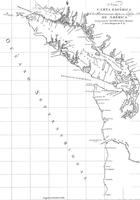Spanish Exploration
SPANISH EXPLORATION of the BC coast in the late 18th century was motivated by concern about a Russian approach to New Spain (Mexico) and later by a search for the Northwest Passage. Spain claimed the entire Pacific coast of America following a late 15th-century papal division of the world between Spain and Portugal. In 1774 Juan PÉREZ left San Blas, Mexico, commanding the Santiago. On 18 July he sighted the northern end of the QUEEN CHARLOTTE ISLANDS and encountered HAIDA people, who launched canoes from Langara Island and traded with his crew. He did not land. Later he anchored off NOOTKA SOUND and again traded with local people but neither landed nor officially claimed the area for Spain. These were the first confirmed contacts between Europeans and aboriginal people on the Northwest Coast.
In 1775 Juan Francisco de la BODEGA Y QUADRA in the Sonora reached 58°30' and explored Bucareli Bay off Prince of Wales Island in Alaska. In 1779, learning of James COOK's plan to search for the Northwest Passage, Spain launched a third expedition. Although a year late to intercept the British mariner, it explored as far as Cook Inlet and Kodiak Island.
LAPÉROUSE's French expedition to the Northwest Coast in 1786 led to renewed Spanish activity. Estéban José MARTÍNEZ explored the Alaskan coast north and west to Unalaska Island in 1788, returning to Mexico with information suggesting a Russian plan to occupy Nootka. The Spanish decided to move first. In 1789 Martínez led an expedition to Nootka, where the Spanish established themselves at the present-day village of YUQUOT in Friendly Cove. Here Martínez seized British fur-trading vessels, touching off the NOOTKA SOUND CONTROVERSY. The Spanish withdrew that fall, but in 1790 Francisco ELIZA brought soldiers under the command of Pedro de ALBERNI to occupy the site more permanently. While a fort and settlement were under construction, Manuel QUIMPER explored into JUAN DE FUCA STRAIT. The Spanish wintered at Nootka, and in 1791 Eliza continued this exploration with José María NARVÁEZ in the tiny schooner Santa Saturnina, becoming the first Europeans to enter GEORGIA STRAIT. Scientists attached to a major expedition commanded by Alejandro MALASPINA visited in the summer of that year, exploring and describing Nootka Sound. When Spain and Britain reached a diplomatic agreement over Nootka Sound, Bodega y Quadra was sent there to negotiate the details with George VANCOUVER. Also during his expedition of summer of 1792, Jacinto CAAMAÑO searched for the Strait of FONTE. Malaspina returned to Mexico in 1791, having learned the details of explorations beyond Juan de Fuca Strait, and persuaded the Viceroy to dispatch 2 officers, Dionisio ALCALÁ-GALIANO and Cayetano VALDÉS, in the Sutil and Mexicana, to continue searching for a passage to the Atlantic. After visiting Nootka, they entered the strait and encountered Capt Vancouver off Point Grey in late June 1792. For 2 weeks the Spanish and British explored together, sharing information as they sailed among the islands separating VANCOUVER ISLAND from the mainland. After parting from the British, Galiano and Valdes took a more easterly route into Queen Charlotte Strait. They entered the Pacific via Goletas Channel and proceeded to Nootka, completing the first circumnavigation of Vancouver Island by Europeans. That fall Bodega y Quadra and Vancouver failed to settle the competing Spanish and British claims; the Nootka affair was ultimately resolved in Europe. In 1795 Spain ended its occupation of Yuquot and, after one final expedition in 1796, ceased maritime activity north of California.

